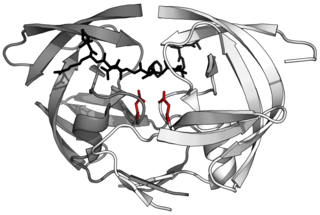Related Research Articles

Cathepsins are proteases found in all animals as well as other organisms. There are approximately a dozen members of this family, which are distinguished by their structure, catalytic mechanism, and which proteins they cleave. Most of the members become activated at the low pH found in lysosomes. Thus, the activity of this family lies almost entirely within those organelles. There are, however, exceptions such as cathepsin K, which works extracellularly after secretion by osteoclasts in bone resorption. Cathepsins have a vital role in mammalian cellular turnover.

Baculoviridae is a family of viruses. Arthropods, among the most studied being Lepidoptera, Hymenoptera and Diptera, serve as natural hosts. Currently, 85 species are placed in this family, assigned to four genera.

Cathepsin S is a protein that in humans is encoded by the CTSS gene. Transcript variants utilizing alternative polyadenylation signals exist for this gene.

Cathepsin K, abbreviated CTSK, is an enzyme that in humans is encoded by the CTSK gene.

Cathepsin C (CTSC) also known as dipeptidyl peptidase I (DPP-I) is a lysosomal exo-cysteine protease belonging to the peptidase C1 protein family, a subgroup of the cysteine cathepsins. In humans, it is encoded by the CTSC gene.

Aspartic proteases are a catalytic type of protease enzymes that use an activated water molecule bound to one or more aspartate residues for catalysis of their peptide substrates. In general, they have two highly conserved aspartates in the active site and are optimally active at acidic pH. Nearly all known aspartyl proteases are inhibited by pepstatin.

Transmembrane protease, serine 2 is an enzyme that in humans is encoded by the TMPRSS2 gene. It belongs to the TMPRSS family of proteins, whose members are transmembrane proteins which have a serine protease activity. The TMPRSS2 protein is found in high concentration in the cell membranes of epithelial cells of the lung and of the prostate, but also in the heart, liver and gastrointestinal tract.

Legumain is a protein that in humans is encoded by the LGMN gene.

Cathepsin L2 is a protein encoded in humans by the CTSV gene.
Cathepsin X is an enzyme. This enzyme catalyses the following chemical reaction

Retroviral aspartyl proteases or retropepsins are single domain aspartyl proteases from retroviruses, retrotransposons, and badnaviruses. These proteases are generally part of a larger pol or gag polyprotein. Retroviral proteases are homologous to a single domain of the two-domain eukaryotic aspartyl proteases such as pepsins, cathepsins, and renins. Retropepsins are members of MEROPS A2, clan AA. All known members are endopeptidases.
The PiggyBac (PB) transposon is a mobile genetic element that efficiently transposes between vectors and chromosomes via a "cut and paste" mechanism. During transposition, the PB transposase recognizes transposon-specific inverted terminal repeat sequences (ITRs) located on both ends of the transposon vector and efficiently moves the contents from the original sites and integrates them into TTAA chromosomal sites. The powerful activity of the PiggyBac transposon system enables genes of interest between the two ITRs in the PB vector to be easily mobilized into target genomes. The TTAA-specific transposon piggyBac is rapidly becoming a highly useful transposon for genetic engineering of a wide variety of species, particularly insects. They were discovered in 1989 by Malcolm Fraser at the University of Notre Dame.
Pestivirus NS3 polyprotein peptidase is an enzyme. This enzyme catalyses the following chemical reaction
Nuclear-inclusion-a endopeptidase is a protease enzyme found in potyviruses. This enzyme catalyses the following chemical reaction:
Calicivirin is an enzyme. This enzyme catalyses the following chemical reaction

The PA clan is the largest group of proteases with common ancestry as identified by structural homology. Members have a chymotrypsin-like fold and similar proteolysis mechanisms but can have identity of <10%. The clan contains both cysteine and serine proteases. PA clan proteases can be found in plants, animals, fungi, eubacteria, archaea and viruses.

The Early 35 kDa protein, or P35 in short, is a baculoviral protein that inhibits apoptosis in the cells infected by the virus. Although baculoviruses infect only invertebrates in nature, ectopic expression of P35 in vertebrate animals and cells also results in inhibition of apoptosis, thus indicating a universal mechanism. P35 has been shown to be a caspase inhibitor with a very wide spectrum of activity both in regard to inhibited caspase types and to species in which the mechanism is conserved.
Helicoverpa zea nudivirus 2 is an enveloped, rod-shaped, nonoccluded, double stranded DNA (dsDNA) sexually transmitted virus whose natural host is the corn earworm moth. At about 440 by 90 nm, it is the causative agent of the only sexually transmitted viral disease of any insect. It was originally identified in a colony of corn earworm moths established and maintained in Stoneville, Mississippi, U.S. and was found to be responsible for the sterility of those infected.
Max Duane Summers is an American molecular biologist and inventor, known for his work on the Baculovirus Expression Vector System (BEVS).

Papain-like proteases are a large protein family of cysteine protease enzymes that share structural and enzymatic properties with the group's namesake member, papain. They are found in all domains of life. In animals, the group is often known as cysteine cathepsins or, in older literature, lysosomal peptidases. In the MEROPS protease enzyme classification system, papain-like proteases form Clan CA. Papain-like proteases share a common catalytic dyad active site featuring a cysteine amino acid residue that acts as a nucleophile.
References
- ↑ Slack JM, Kuzio J, Faulkner P (May 1995). "Characterization of v-cath, a cathepsin L-like proteinase expressed by the baculovirus Autographa californica multiple nuclear polyhedrosis virus". The Journal of General Virology. 76 ( Pt 5) (5): 1091–8. doi: 10.1099/0022-1317-76-5-1091 . PMID 7730794.
- ↑ Hawtin RE, Zarkowska T, Arnold K, Thomas CJ, Gooday GW, King LA, Kuzio JA, Possee RD (November 1997). "Liquefaction of Autographa californica nucleopolyhedrovirus-infected insects is dependent on the integrity of virus-encoded chitinase and cathepsin genes". Virology. 238 (2): 243–53. doi: 10.1006/viro.1997.8816 . PMID 9400597.